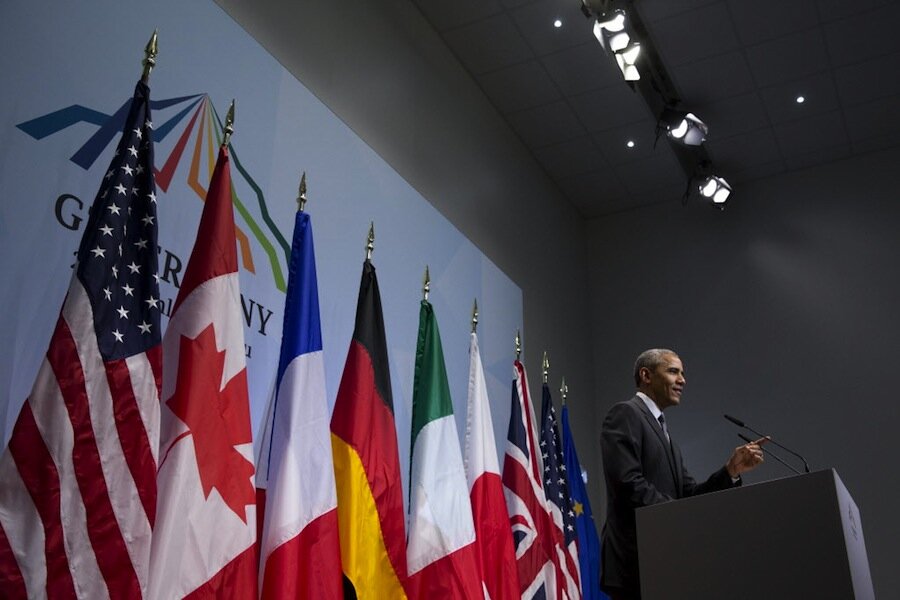G7 pledges to end greenhouse emissions this century
Loading...
| Washington
Top world leaders agreed Monday to dramatically reduce or altogether eliminate greenhouse gas emissions by 2100, in an announcement meant to build momentum for a global climate deal in Paris this December.
Pressure continues to mount on world leaders to accelerate a switch to cleaner energy sources – particularly if the world is to avert the worst impacts of climate change. Emissions from coal, oil, and natural gas burned in power plants, cars, airplanes, and elsewhere have already warmed the planet significantly above pre-industrial temperatures, scientists say.
Some say it may even be too late to meet a widely acknowledged international goal of limiting warming to 2 degrees Celsius (3.6 degrees Fahrenheit). But at its meeting in Germany’s Bavarian Alps Monday, the G7 reaffirmed an intent to meet previously established targets.
“The G7 leaders issued a powerful statement on climate change today, committing themselves to aggressive action to reduce greenhouse gas emissions and to lead the decarbonization of the global economy," World Bank President Jim Yong Kim said in a statement Monday.
Meanwhile, a draft of the Paris climate agreement is taking shape this week on the banks of the Rhine in Bonn, Germany. The deal is composed of individual countries’ pledges to cut emissions, which negotiators will stitch into an international deal come December.
But many hurdles remain for negotiators, who hope to avoid a repeat of Copenhagen climate talks that collapsed in 2009. Though the wealthy G7 countries (Canada, France, Germany, Italy, Japan, the UK, and the US) have all submitted emissions-cutting pledges to the UN, much of the world has not. India, for example, has yet to promise emissions reductions, despite being the world’s third largest carbon emitter.
China, the world’s largest emitter, has pledged to peak its emissions by 2030, and some estimates show emissions could peak as early as 2025. But for much of the developing world, emissions-cutting commitments are likely to depend heavily on how much financial support the developed world offers. Poor countries are expected to endure the worst impacts of climate change, from sea level rise to desertification, and climate finance from rich nations could encourage them to sign on to an emissions-cutting deal.
To that end, the G7’s “commitment to increase renewable energy access in Africa and address climate risks from disasters will help build trust with developing countries ahead of the climate negotiations in Paris,” says Jennifer Morgan, director of the global climate program at the World Resources Institute, an environmental think tank, in a statement Monday.
It’s unclear if the US can even follow through on its own pledges, however. President Obama has promised to cut US emissions 26 to 28 percent from 2005 levels by 2025, but that commitment relies almost exclusively on executive authority, meaning a future administration could scrap the targets all together. Obama also promised $3 billion to help developing countries adapt to extreme weather, but Republicans in Congress have put that pledge on the chopping block as well.
The White House has acknowledged that there are difficulties in committing to long-term reductions in emissions, particularly on the political front.
“[M]aking these kinds of commitments to reduce carbon pollution post-2020” is not easy, White House press secretary Josh Earnest told reporters in Germany. “The President’s view is that ... if we can continue to make investments in renewable energy – things like wind and solar – if we can make continued gains when it comes to efficiency, that that will have important economic benefits for the country as a whole.”
Experts say that with each passing year the 2-degree Celsius goal becomes more and more difficult to achieve, especially given the emissions reductions countries have put forward so far.
At the very least, Monday’s decarbonization announcement signals a growing commitment to renewables in the G7.
“For the first time ever, G7 leaders have rallied behind a long-term goal to decarbonize the global economy,” Ms. Morgan says. “This target must also be a key element of an ambitious international climate agreement.”
But 2100 is a long way off, and demand for cheap power from fossil fuels is still growing in countries like India and China.
“[O]il companies will predict that fossil fuels will remain dominant into the 22nd- and perhaps even the 23rd-century,” Tom Kloza, global head of energy analysis at the Oil Price Information Service, tells MarketWatch. “[B]ut I sense more traction for the anti-carbon foes.”







